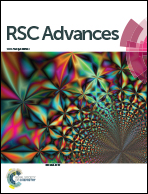A novel approach for testing the teratogenic potential of chemicals on the platform of metabolomics: studies employing HR-MAS nuclear magnetic resonance spectroscopy†
Abstract
NMR based metabolomics offers a complementary approach that gives information on whole-organism functional integrity over time after drug exposure. Hence the objective was to develop a quick, reliable method for testing the teratogenic potential of a new chemical entity (NCE) on the platform of metabonomics, as an alternative to conventional procedures. Time mated Charles Foster rats (n = 9) were injected with cyclophosphamide (0, 5, 15 and 30 mg kg−1) at different dose levels on day 11 of the pregnancy, through an i.p. route. On day 12 of the pregnancy, embryos were procured from six rats out of the 9 pregnant rats from each group, using a per abdominal approach. These embryos were then undertaken for morphological studies and NMR experiments using a high resolution-magic angle spin (HR-MAS) probe. The remaining three rats were followed until term to procure full term pups, which were used for conventional observations and studies. Multivariate unsupervised principal component analysis of the 1H NMR spectra from the rat embryos revealed a dose dependent cluster separation between the controls and treated specimens, which was further confirmed by supervised partial least-squares discriminant analysis with an R2 of 0.77 and Q2 of 0.72. Those embryos which were found to have malformations/anomalies, significantly presented a few upregulated (aspartate) and a few downregulated (creatine, choline and glycine) metabolite levels. This work revealed that observed teratogenic ailments and resulting metabolic profiles have a definite correlation, demonstrating the suitability of this procedure for testing teratogenicity, which may give a new dimension to the prioritization of lists having a large number of chemicals to be tested for their teratogenicity. Malformations observed among the full term pups also validated the findings from the embryos.


 Please wait while we load your content...
Please wait while we load your content...